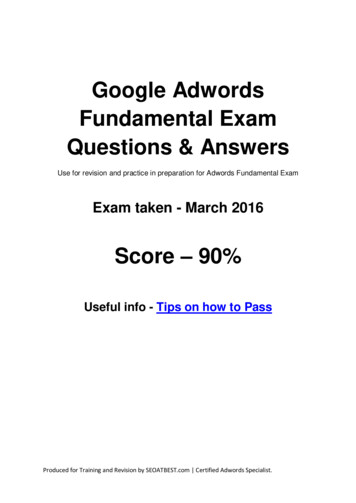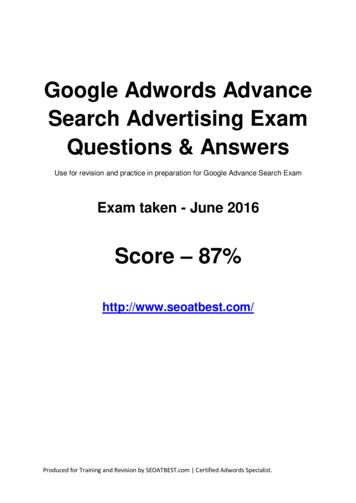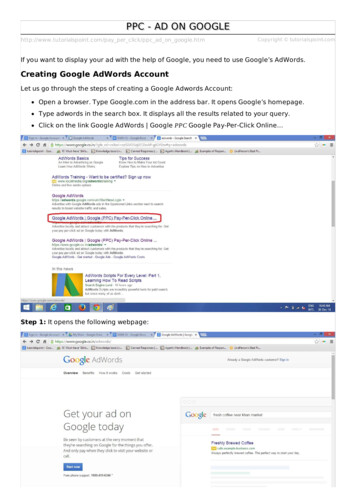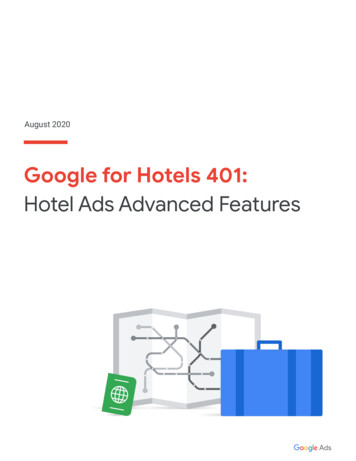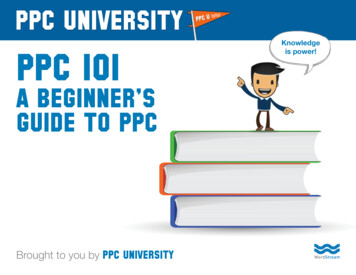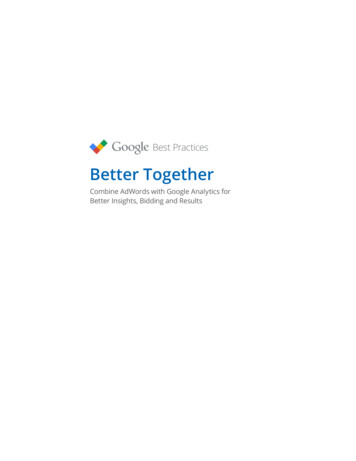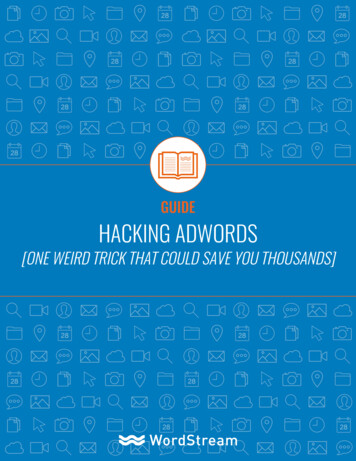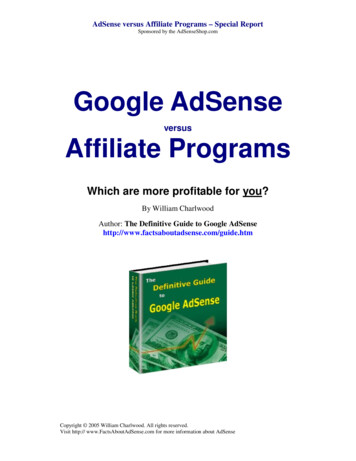
Transcription
Setting SmarterSearch BidsInside Automated Bidding with AdWords
Table of ContentsThe bidding challenge. Page 3The AdWords automated bidding solution . Page 3Part 1: True auction-time bidding. Page 3Part 2: Adaptive learning at the query level. Page 5Part 3: Richer contextual signals and cross-signal analysis. Page 5When signals work together . Page 8Portfolio bid strategies to help you meet your goals . Page 9Conversion and revenue-based bid strategies . Page 9Awareness-based bid strategies . Page 9How AdWords calculates bids. Page 10How our bidding algorithms learn . Page 12Setting a bid strategy up for success. Page 12Adapting to your performance changes. Page 14Key takeaways . Page 15Setting Smarter Search Bids2
The bidding challengeIntelligent bid optimization is a keystone of any successful search campaign. The keyword bids you choose directlyinfluence your campaign performance and how visible your ads are for the search queries most important to yourbusiness. Without regular, data-driven bidding oversight, you could find yourself spending too much on the wrongkeywords while missing out on valuable conversions and revenue.It can be challenging to scalably manage your bids to achieve the best results, especially if you have campaigns witha significant number of keywords and are trying to optimize across multiple dimensions like match type, device andlocation. Given the dynamic nature of search auctions, the “right” bid can often be a moving target as well. This is whymarketers often choose automated bidding solutions to make frequent bid optimizations using comprehensive datamodels. These solutions can help marketers make better bidding decisions not only on their highest-volume headterms, but also on their low-volume terms to drive significant performance gains. Furthermore, advertisers can savehours per week when they transition from manual to automated bidding, and reclaim valuable time they can reinvestin other strategic optimizations.The AdWords automated bidding solutionAdWords automated bidding is an enterprise-class solution that helps advertisers set precise bids for each and everyauction, and helps drive higher conversion volume or revenue at a cost-efficiency that is comparable to or better thanexisting performance targets. It offers three core capabilities not available in any other tool:1.True auction-time bidding2.Adaptive learning at the query-level3.Richer user signals and cross-signal analysisLet’s explore each of these in more detail.1. True auction-time biddingFor conversion and revenue-based bid strategies, AdWords automated bidding offers true auction-time optimizationthat sets bids for each individual auction, not just a few times a day. This gives advertisers a more precise level of bidoptimization and the ability to tailor bids to each user’s unique search context. Rather than only adjusting bids basedon aggregate performance across users, AdWords bidding algorithms also evaluate relevant contextual signals presentat auction-time such as the time of day, the specific ad creative being shown, or the user’s device, location, browser,and operating system.Setting Smarter Search Bids3
Identifying the conversion opportunity of each and every auction helps to differentiate bids and optimize with a higherdegree of precision. For example, a banking advertiser may identify that iOS users are more likely to open a checkingaccount, or that smartphone users located in cities with higher branch coverage are more likely to visit a bank location.With auction-time bidding, AdWords can detect the presence of signals like these to more accurately predict conversionrate and set a more informed bid for every search query.Today’s bidding solutions offer varying levels of bidding frequency and precisionMarketers can choose from a variety of bidding methods to manage their keywords, so it’s important to understandthe incremental benefits of each solution: Manual bidding: Advertisers manually set keyword bids themselves, with the option to use performancefilters (e.g. for keywords with a conversion rate higher than x%, increase bids by y%). Due to time constraints,advertisers may only optimize bids for a subset of their keywords during each round of optimization, suchas top-performers or by keyword or product category. Rules-based bidding: Advertisers define performance criteria and a system automatically adjusts bidswhen keyword performance meets those criteria (e.g. when average position falls below x, increase bids y%). Intra-day bidding: Machine-learning algorithms train on historical and ongoing performance data tooptimize keyword bids and bid adjustments a few times a day. This is often referred to as “real-time”bidding for search marketing, as some tools have the ability to register new conversion data as soonas it happens.The DoubleClick Search management platform optimizes bids at least four times a day whilerefreshing its conversion models multiple times per hour. It allows advertisers to set up portfoliobid strategies that span multiple search engines and accounts. Learn More. AdWords auction-time bidding: AdWords automated bidding combines machine learning algorithmswith bid optimization for each and every auction. This is the most precise, granular level you canuse to set your bids. Comparatively, even when keyword bids and bid adjustments are modified a fewtimes a day, they are still applied uniformly across every user. Ultimately, you can underbid for yourstrongest-performing auctions while overbidding for poorer-performing ones.You can implement an AdWords automated bid strategy to get the benefits of auction-timebidding while still using a third-party search management solution for bulk edits and reportingacross multiple accounts and search engines.Setting Smarter Search Bids4
2. Adaptive learning at the query levelMachine learning algorithms rely on robust conversion data to build accurate bidding models that predict performanceat different bid levels. While high-volume head terms often provide plenty of conversion rate data for modeling, accountstypically have some low-volume or new keywords with little performance history that must be taken into account.For these low-volume keywords, bidding solutions rely on models to set bids that are the best estimate of conversionrates at that time.For example, bidding solutions may test different bid levels to build the conversion rate model for a specific keyword.However, this may result in poor performance while the keyword accrues data, which can be a lengthy processdepending on search volume. Another common process for modeling conversion rate performance on low-volumekeywords is to “borrow” data from the same keyword across match types or from higher-level ad group andcampaign performance.AdWords automated bidding expands upon this method and augments it by using query-level data across similarauctions. This gives the bidding algorithms significantly more data to make decisions with, and helps reduceperformance fluctuations when keyword-level conversion data is scarce.Why query-level learning improves your biddingAdWords bidding models aren’t limited and compartmentalized by where a keyword lives in your accountstructure. Instead, conversion data can be leveraged at the search query level across ad groups and campaigns.This is especially beneficial for optimizing bids on phrase and broad match keywords, where a wide variety ofsearch queries may match to a single keyword. In these cases, having just one keyword-level bid won’t optimizefor conversion rate differences across queries.Furthermore, let’s say you add new keywords or move keywords to a different ad group. AdWords algorithms don’thave to relearn performance from scratch. Because they learn at the query-level rather than the keyword-level, ifa search query has already been matching to other parts of your campaigns and similar auctions, the algorithmssimply apply what they’ve learned about it across your account to make smarter bidding decisions.3. Richer contextual signals and cross-signal analysisEvery user search is different and bids for each query should reflect the unique contextual signals present at auction-time.Signals like time of day, presence on a remarketing list, or a user’s device and location are key dimensions to considerwhen determining optimal bids. On top of evaluating these signals, AdWords automated bidding includes additionalsignals like a user’s operating system, web browser, language settings, and many more to optimize for performancedifferences across platforms and users. This helps capture meaningful context for every search, allowing AdWords tomore accurately predict the conversion likelihood of each auction and set the optimal bid. See a list of several of theimportant predictive signals AdWords automated bidding uses below.Setting Smarter Search Bids5
ContextualsignalsDescriptionExampleDeviceSystem can optimize bids based onAdvertiser: Car dealershipwhether the query is coming fromBids take into account if a user searches for “cardesktop, tablet or mobiledealer locations” on a desktop computer at homeor from a smartphone while on the goLocationSystem can optimize bids basedAdvertiser: Bankon the specific location (down toEven if location targeting is set to New York state,the city level) the user is locatedin or searching for, even if locationtargeting is set ata higher levelWeekday /time of daychecking account” from different cities within thestate (e.g. Manhattan vs. Long Island where theremay be differing branch coverage)System can optimize bids based onAdvertiser: Coffee shopthe user’s local time of day and dayBids take into account if a user searches at 7amof week in their time zoneList basedaudiences(RLSA, CustomerMatch, similaraudience)bids take into account if a user searches for “newbefore work vs. noon at lunchtime on MondaySystem takes audience lists forAdvertiser: Online retailersearch ads into accountBids take into account if a user has browsed aproduct during a previous site visit, is part of theCRM base, or has a profile similar to existingcustomers. It also accounts for how recently theuser was last seenActual querySystem can optimize bids based onAdvertiser: Shoe retailerthe text of the query that triggeredBids take into account if a user’s query is “leatherthe ad, not just the keyword itmatches toAd creativeboots” or “boot repairs,” even if both queries broadmatch to the keyword “boots”When you have multiple ad creativesAdvertiser: Online travel companyeligible to serve for a given searchBids take into account if ad shown is the “latestquery, system can optimize thebid based on which creative will beshown, including whether it drives toa mobile appdeals” creative or the “popular getaways” creative, orif it points to the mobile site or app, based on whichvariation has a higher likelihood of converting for thespecific querySetting Smarter Search Bids6
ContextualsignalsDescriptionExampleInterfaceSystem can optimize bids basedAdvertiser: Spanish language learning sitelanguageon the particular user’s languageFor the query, “learn a new language”, bids take intopreferenceaccount whether ad is shown to a user whose Googlelanguage setting is English or SpanishBrowserSystem can optimize bids based onAdvertiser: Software companythe browser the query is coming fromBids take into account if a user searches for “macsoftware” from Safari or Internet ExplorerOSSystem can optimize bids basedAdvertiser: Phone accessories selleron the user’s operating systemBids take into account if a user searches for “Nexusfor that querySearch Networkpartner6 phone case” from an Android or iOS deviceSystem can optimize bids basedAdvertiser: Consumer packaged goods brandon which search partner the adsDifferent bids placed if query is coming fromappears onmore relevant searches on an eCommerce sitevs. a news siteDemographics(age and gender)System can optimize bids usingAdvertiser: Online retailerdemographics for Search Ads (DFSA)Bids take into account how likely a user is toconvert based on age and genderMobile appratings andreviewsSystem can optimize bids basedAdvertiser: Gaming companyon app user ratings and numberDifferent bids placed based on the rating andof reviewsnumber of reviews your apps hasSetting Smarter Search Bids7
When signals work togetherWhile implementing manual bid adjustments for individual signals like device and location is a great first step to settingmore precise bids, AdWords automated bidding goes a step beyond traditional signal analysis. Search context is neverdefined by just one signal, and AdWords can recognize and adjust for meaningful interactions between combinationsof signals that can impact conversion rates.Evaluating signals individually vs. analyzing cross-signal effectsIndividual bid adjustments for signals such as device, location, and time of day look at performance data inaggregate. For example, a bidding solution may evaluate how your mobile conversion rate across userscompares to your overall computer and tablet conversion rate, and set a corresponding mobile bid adjustment.Although this method of aggregating data and evaluating performance averages helps to avoid making bidadjustments with insufficient data, it can also overlook the nuanced conversion opportunity between individualauctions. For example, a mortgage lender might determine that on average, their mobile conversion rates are20% lower than computer and tablet conversion rates, and set a mobile bid adjustment of -20%. However, thisdoesn’t account for the times of day where their mobile conversion rates are strong, such as in the mornings,when people may be researching loan options on their phones during their early work commute.Furthermore, when you begin to layer on additional bid adjustments (e.g. for location), calculating them individuallyand then multiplying them together doesn’t account for the interacting effects of the signals together. It caneven produce unreasonably high bids if you combine multiple, large bid increases with a base keyword bid that’salready high.AdWords evaluates how signals interact with each other to identify meaningful correlations that impactconversion rate across advertisers. By seeing which signal combinations are most predictive of conversionperformance and adding these to the bidding models, it can calculate more holistic bids that account forhow certain signals work together.Example of exclusive signals for AdWords Smart BiddingSignals available with bid nCombinationsbetween 2 ormore earchpartnerBidSetting Smarter Search Bids8
Portfolio bid strategies to help you meet your goalsAdWords offers multiple automated bidding strategies to help you reach performance objectives. Some like Target CPAor Target ROAS can be used as portfolios of campaigns.Conversion and revenue-based bid strategies:PerformanceBid strategyWhen to use it takes the keyword-level bids and bid adjustments you’ve implemented into account to get you more conversionsat your current CPA through auction-time bidding. For a given keyword, our algorithms will adjust the bid up or downbased on that auction’s predicted conversion rate compared to the average conversion rate across auctions. However,the full power of automated bidding is limited by only working on a portion of your traffic, while still trying to keep eachkeyword’s average CPC below your max CPC.Awareness-based bid strategies Maximize clicks: The same bid is applied across keywords in the bid strategy and is adjusted up or down toensure you hit your campaign budgets while getting as many clicks as possible.If your goal is to maximize clicks and you value each click equally, our research has found that applyinguniform bids across keywords, adjusted up or down based on budget utilization, can be as effective astailoring unique bids for every keyword. Our Maximize clicks bid strategy leverages this finding to getyou the most clicks for your budget and is especially effective in cases where individual keywords havesparse or highly variable click volume. Target outranking share: AdWords uses auction insights data from your account to model your outrankingshare against other advertisers participating in the same auctions with you. Your bids are then adjusted tomeet the outranking share target you set.Setting Smarter Search Bids11
Target search page location: Your bids are adjusted up or down to meet the estimated top of page bid orestimated first page bid, depending on which you choose.How our bidding algorithms learnSetting a bid strategy up for successLaunching a bid strategy with a solid foundation of conversion data can help drive faster results by speeding up theinitial “learning period” required for algorithms to build and customize performance models for your business. It typicallytakes 1-2 weeks for our algorithms to calibrate for a newly created bid strategy, although this largely depends on theamount of conversion data present.Number of ConversionsCPA FluctuationInitial Learning Period30Medium to HighSlow60MediumMedium100LowFast500Very LowVery Fast(in the past 30 days)Test changes and understand their impact before committing with drafts and experimentsIt is now possible to seamlessly test Smart Bidding using drafts and experiments. You can use drafts to preparemultiple changes to a campaign. From there, you can either apply your draft’s changes back to the originalcampaign or use your draft to create an experiment. Experiments help you measure your results to understandthe impact of Smart Bidding before you apply it to a campaign.Revenue-based bid strategies tend to see greater performance variance since conversion values/revenue fluctuate inaddition to conversion rates. As a result, for a bid strategy like Target ROAS, we recommend a conversion threshold ofat least 30 conversions in the past 30 days.Setting Smarter Search Bids12
Number of ConversionsROAS FluctuationInitial Learning Period50Medium to HighSlow100MediumMedium200LowFast500Very LowVery Fast(in the past 30 days)Bid strategy statuses provide insight into what’s going on under the hoodAdWords bid strategy statuses give you deeper transparency into how your automated bid strategies areperforming. For example, if a strategy is still in “Learning” status because you recently created it or changed thecomposition of its campaigns, ad groups or keywords, we will display the “estimated time left in learning” and“days since the last significant change”. These indicate that the algorithms are still calibrating and how muchlonger you should wait before making any other changes or evaluating what baseline performance looks like.Alternatively, if your bid strategy lacks conversion data, we’ll flag this with the “Limited (not enough data)”status and show you the recommended conversion volume thresholds to help AdWords better optimize bids.In instances where you have little to no conversion data available, AdWords automated bidding can still leveragequery-level data from similar auctions outside your bid strategy to build more accurate initial conversion rate modelsand make more informed bidding decisions from the start. It then uses Bayesian learning to continuously update andimprove these models as it accrues conversion rate data at more granular levels (e.g. for a search query mapped tospecific versions of ad copy or landing pages).Make every conversion count using cross-device dataHaving sufficient conversion data is critical for successful automated bidding. This can be a challenge in today’smobile world, where over 90% of users move between different screens when completing a task1. This presentsadvertisers with the tough challenge of fully measuring consumer journeys that start with an ad click on onedevice, but end with a conversion on another. In fact, advertisers around the world have measured up to 16% moreconversions after accounting for cross-device data2.AdWords helps advertisers bridge this measurement gap by not only capturing cross-device conversions, but alsoallowing you to take direct action on this data through automated bidding. This helps ensure that you’re makinginformed bidding decisions with a more complete data set, and not undervaluing clicks on devices that may bedriving more conversions than what traditional, tag-based measurement alone would show you.1Industry Multi-Screen Study, Google/Ipsos, 20132Google AdWords Internal Data, 2015Setting Smarter Search Bids13
You can also use AdWords Data-Driven Attribution (DDA) modeling to understand the actual contribution of eachkeyword across the conversion path. DDA is fully integrated with automated bidding in AdWords. If you use anautomated bidding strategy to drive more conversions, your bids will use this data to help you meet your goal.Adapting to your performance changesAs your business grows and you make adjustments to your campaigns, AdWords continues to update your biddingmodels to align with any corresponding shifts in performance. On average, it takes at least one conversion cycleto adjust to performance changes that may result from internal factors like adding new keywords, testing new adcopy or updating landing pages, or external factors like seasonality or competition.We define a conversion cycle as the typical amount of time it takes for a click to result in a conversion. For example,if the majority of clicks yield conversions within seven days, we would expect the system to adjust to changes inconversion performance within approximately seven days.“Days to Conversion” can be found in Attribution and Time Lag reports within your AdWords account to help youdetermine what your average conversion cycle is.Adjusting performance targets in advance of short-term conversion changesAdWords bidding algorithms work to prevent hyperactivity and sudden bid changes based on limited data to ensure thatthey optimize based on real performance trends rather than random fluctuations. At the same time, we recognize thatadvertisers often have known events that will impact conversion performance for a short period of time. For example,they may be planning a weekend sale, performing website maintenance or even running a TV spot during Black Friday.To accommodate these brief, anticipated changes in performance, we recommend that advertisers adjust their biddingtargets (target CPA or target ROAS) proportionately to the predicted increase or decrease in conversion rate or value.This way, they can adapt automated bidding to short-term changes without disrupting performance in the longer-term.For example, if the conversion rate suddenly jumps from 2% to 4% during the first hour of Black Friday, you shouldtemporarily double the CPA target while the algorithm adjusts to the new trend. This only needs to be done if conversionrates have changed very rapidly. In most cases, Smart Bidding will automatically handle seasonal increase in trafficwithout requiring any input.Adjusting for data recency and conversion delaysOur algorithms apply adaptive historical weighting to rely more heavily on recent data in bidding decisions while alsoaccounting for the length of your conversion cycle. We recognize that recent performance is likely more predictiveof future performance, but that recency calculations should weigh less heavily against clicks that aren’t yet seeingconversions solely due to conversion delays. A conversion delay is defined as the latency period between an ad clickand the eventual conversion.Setting Smarter Search Bids14
For example, if you’re an advertiser such as a car dealership or travel booking company with lengthier conversioncycles, your recent data may not be as useful because those ad clicks require a longer period of time to yieldconversions. As a result, we’ll weigh that recent data less heavily compared to advertisers with shorter conversioncycles such as a clothing retailer or food delivery service. This helps prevent overreactions to recent clicks that areexperiencing conversion delays, which could lead to unnecessary bid reductions. We also automate this process sothat advertisers don’t have to manually calculate and frequently adjust for these conversion delays themselves.Key takeawaysAdWords automated bidding helps marketers optimize bids at scale across various performance goals and leveragepowerful machine learning capabilities unique to Google: True auction-time bid optimization: AdWords automated bidding optimizes bids for each and every auction,helping you set more precise bids tailored to each user’s search context and meet your performance targetsmore effectively. Query-level performance modeling: AdWords leverages search query-level conversion data across youraccount to help solve for data scarcity that individual keywords may face. This allows the algorithms tobid more accurately on low-volume keywords or keywords that are still building performance history. Evaluat
differences across platforms and users. This helps capture meaningful context for every search, allowing AdWords to more accurately predict the conversion likelihood of each auction and set the optimal bid. See a list of several of the important predictive signals AdWords automated bidding uses below. Why query-level learning improves your bidding

